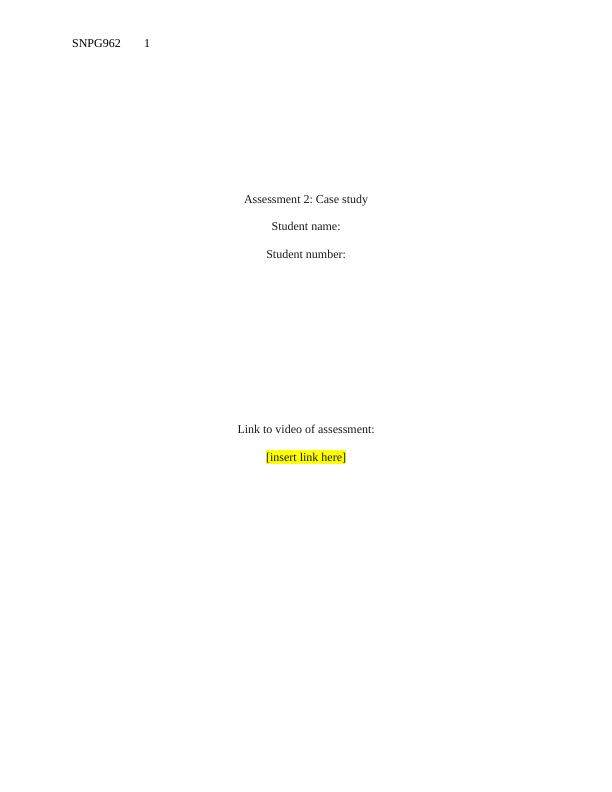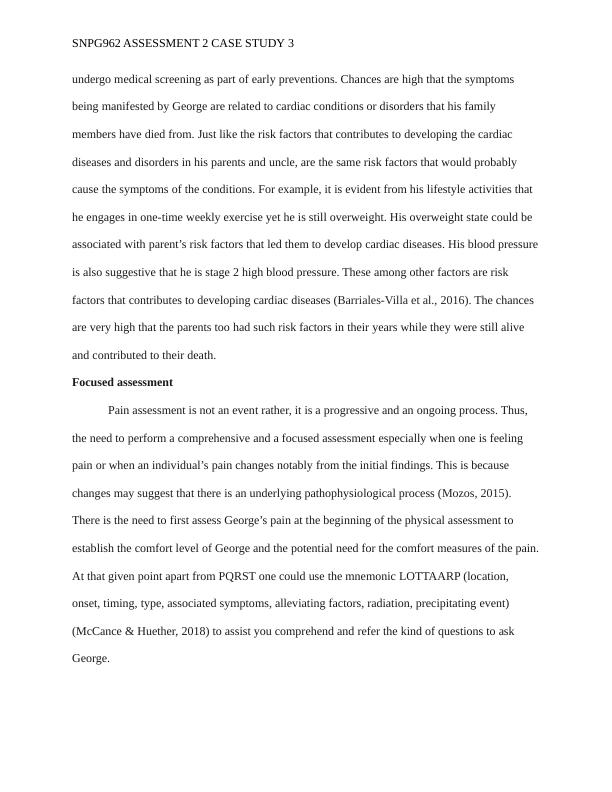Analysis of Findings: Hereditary Cardiovascular Diseases
Added on 2022-12-01
9 Pages2377 Words494 Views
SNPG962 1
Assessment 2: Case study
Student name:
Student number:
Link to video of assessment:
[insert link here]
Assessment 2: Case study
Student name:
Student number:
Link to video of assessment:
[insert link here]

SNPG962 ASSESSMENT 2 CASE STUDY 2
Assessment 2: Case study
Analysis of findings
Health history
It is evident from the case study that George’s condition has a lot to do with the what his
family members have experienced or gone through. Many cardiac disorders could be inherited
according to Zipes et al. (2018). These cardiac disorders ranges from arrhythmias, high blood
cholesterol, coronary heart diseases and congenital heart diseases. From the family history it is
likely that cardiac disorders have been hereditary as evident from the case of the father, mother
and the uncle. Mogensen et al. (2015) notes that coronary heart diseases that ultimately lead to
heart failure, stroke and stroke could run from families suggesting inherited risk factors that are
genetic. Genetics could contribute to the risk for various cardiovascular diseases in diverse ways.
Every aspect of the cardiovascular system is controlled by the genes, from the strength of the
blood vessels to the communication of the heart cells. It therefore means that any cell mutation in
one gene can risk developing heart diseases. For instance, like in George’s case, there are
chances that may be a change in the functioning of a protein in the body such that cholesterol is
synthesized differently from the normal way, thus elevating the chances of blocking the arteries
(Baudhuin et al., 2017). These variations in genes are usually passed from the mother and father
to the young ones through the DNA of the sperm and egg. Everybody cell of a child then
possesses the genetic code from the parent during their development.
For this reason, because there are family members that have been diagnosed with certain
heart diseases and disorders, George is encouraged to undergo screening for any potential risk
factors. It is recommendable for family members who have any victim of cardiac death to
Assessment 2: Case study
Analysis of findings
Health history
It is evident from the case study that George’s condition has a lot to do with the what his
family members have experienced or gone through. Many cardiac disorders could be inherited
according to Zipes et al. (2018). These cardiac disorders ranges from arrhythmias, high blood
cholesterol, coronary heart diseases and congenital heart diseases. From the family history it is
likely that cardiac disorders have been hereditary as evident from the case of the father, mother
and the uncle. Mogensen et al. (2015) notes that coronary heart diseases that ultimately lead to
heart failure, stroke and stroke could run from families suggesting inherited risk factors that are
genetic. Genetics could contribute to the risk for various cardiovascular diseases in diverse ways.
Every aspect of the cardiovascular system is controlled by the genes, from the strength of the
blood vessels to the communication of the heart cells. It therefore means that any cell mutation in
one gene can risk developing heart diseases. For instance, like in George’s case, there are
chances that may be a change in the functioning of a protein in the body such that cholesterol is
synthesized differently from the normal way, thus elevating the chances of blocking the arteries
(Baudhuin et al., 2017). These variations in genes are usually passed from the mother and father
to the young ones through the DNA of the sperm and egg. Everybody cell of a child then
possesses the genetic code from the parent during their development.
For this reason, because there are family members that have been diagnosed with certain
heart diseases and disorders, George is encouraged to undergo screening for any potential risk
factors. It is recommendable for family members who have any victim of cardiac death to

SNPG962 ASSESSMENT 2 CASE STUDY 3
undergo medical screening as part of early preventions. Chances are high that the symptoms
being manifested by George are related to cardiac conditions or disorders that his family
members have died from. Just like the risk factors that contributes to developing the cardiac
diseases and disorders in his parents and uncle, are the same risk factors that would probably
cause the symptoms of the conditions. For example, it is evident from his lifestyle activities that
he engages in one-time weekly exercise yet he is still overweight. His overweight state could be
associated with parent’s risk factors that led them to develop cardiac diseases. His blood pressure
is also suggestive that he is stage 2 high blood pressure. These among other factors are risk
factors that contributes to developing cardiac diseases (Barriales-Villa et al., 2016). The chances
are very high that the parents too had such risk factors in their years while they were still alive
and contributed to their death.
Focused assessment
Pain assessment is not an event rather, it is a progressive and an ongoing process. Thus,
the need to perform a comprehensive and a focused assessment especially when one is feeling
pain or when an individual’s pain changes notably from the initial findings. This is because
changes may suggest that there is an underlying pathophysiological process (Mozos, 2015).
There is the need to first assess George’s pain at the beginning of the physical assessment to
establish the comfort level of George and the potential need for the comfort measures of the pain.
At that given point apart from PQRST one could use the mnemonic LOTTAARP (location,
onset, timing, type, associated symptoms, alleviating factors, radiation, precipitating event)
(McCance & Huether, 2018) to assist you comprehend and refer the kind of questions to ask
George.
undergo medical screening as part of early preventions. Chances are high that the symptoms
being manifested by George are related to cardiac conditions or disorders that his family
members have died from. Just like the risk factors that contributes to developing the cardiac
diseases and disorders in his parents and uncle, are the same risk factors that would probably
cause the symptoms of the conditions. For example, it is evident from his lifestyle activities that
he engages in one-time weekly exercise yet he is still overweight. His overweight state could be
associated with parent’s risk factors that led them to develop cardiac diseases. His blood pressure
is also suggestive that he is stage 2 high blood pressure. These among other factors are risk
factors that contributes to developing cardiac diseases (Barriales-Villa et al., 2016). The chances
are very high that the parents too had such risk factors in their years while they were still alive
and contributed to their death.
Focused assessment
Pain assessment is not an event rather, it is a progressive and an ongoing process. Thus,
the need to perform a comprehensive and a focused assessment especially when one is feeling
pain or when an individual’s pain changes notably from the initial findings. This is because
changes may suggest that there is an underlying pathophysiological process (Mozos, 2015).
There is the need to first assess George’s pain at the beginning of the physical assessment to
establish the comfort level of George and the potential need for the comfort measures of the pain.
At that given point apart from PQRST one could use the mnemonic LOTTAARP (location,
onset, timing, type, associated symptoms, alleviating factors, radiation, precipitating event)
(McCance & Huether, 2018) to assist you comprehend and refer the kind of questions to ask
George.

End of preview
Want to access all the pages? Upload your documents or become a member.
Related Documents
Assignment on Tangier Diseaselg...
|7
|1600
|42
Clinical Analysis Assessment 2022lg...
|7
|1814
|227
Familial Hypercholesterolemia: Causes, Symptoms, and Treatmentlg...
|9
|2277
|345
Congestive Cardiac Failurelg...
|15
|2802
|163
Hyperlipidaemia: Causes, Symptoms, Risk Assessment, and Care Planlg...
|27
|1320
|238
Genetics, Phenotype, Prevalence, Symptoms, Risk Assessment and Interventions for Cardiovascular Diseaselg...
|25
|1458
|226